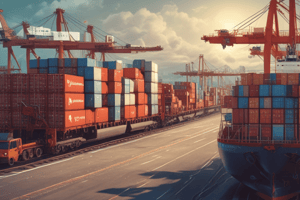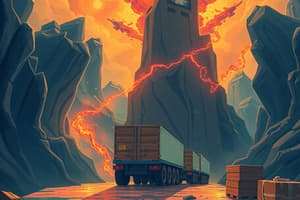Podcast
Questions and Answers
Before the pandemic, what made Platinum Optics' supply chain structure efficient?
Before the pandemic, what made Platinum Optics' supply chain structure efficient?
It was cost-effective.
What is a dual-sourcing strategy, and why is it important for Platinum Optics?
What is a dual-sourcing strategy, and why is it important for Platinum Optics?
Sourcing critical components from two or more geographically distinct locations. It prevents a single country's shutdown from completely disrupting operations.
What is the problem with relying solely on stockpiled inventory as a solution to supply chain disruptions?
What is the problem with relying solely on stockpiled inventory as a solution to supply chain disruptions?
It is not viable long-term, as demand can fluctuate and stockpiling increases holding costs.
Besides China, which countries are identified as potential alternative sourcing locations?
Besides China, which countries are identified as potential alternative sourcing locations?
How can increasing the share of suppliers in North America improve Platinum Optics' supply chain?
How can increasing the share of suppliers in North America improve Platinum Optics' supply chain?
What is the suggested approach to refining the inventory strategy, regarding what components to store?
What is the suggested approach to refining the inventory strategy, regarding what components to store?
What key digital supply chain technologies can mitigate future risks for Platinum Optics?
What key digital supply chain technologies can mitigate future risks for Platinum Optics?
What is one major takeaway regarding supplier diversification?
What is one major takeaway regarding supplier diversification?
How can investing in automation help counter the potential drawbacks of U.S.-based production?
How can investing in automation help counter the potential drawbacks of U.S.-based production?
What advantage can a company with a resilient, flexible, and well-managed supply chain gain?
What advantage can a company with a resilient, flexible, and well-managed supply chain gain?
Flashcards
Single-Source Location Risk
Single-Source Location Risk
Relying on a single geographic location for critical components, making the supply chain vulnerable to disruptions.
Dual-Sourcing Strategy
Dual-Sourcing Strategy
Sourcing critical components from two or more geographically distinct locations to prevent disruptions from a single point of failure.
Supplier Diversification
Supplier Diversification
Reducing dependence on specific regions and cultivating new suppliers elsewhere for stable material flow.
Predictive Analytics in Supply Chain
Predictive Analytics in Supply Chain
Signup and view all the flashcards
Permanent Diversification
Permanent Diversification
Signup and view all the flashcards
Domestic Production & Automation
Domestic Production & Automation
Signup and view all the flashcards
Strategic Supply Chain Adaptation
Strategic Supply Chain Adaptation
Signup and view all the flashcards
Study Notes
Risks in Current Supply Chain
- Platinum Optics relies on China for 85% of raw materials, with only 15% sourced from the U.S., Singapore, and Malaysia.
- COVID-19 related lockdowns in China and travel restrictions disrupted production and logistics.
- Supply chain bottlenecks delayed shipments to 300 customers in North and South America.
- 10 million in stockpiled inventory was a short-term buffer.
- Over-reliance on inventory is not viable due to fluctuating demand and high holding costs.
- The existing supply chain structure is vulnerable to global disruptions.
Building a Resilient Supply Chain
- Diversifying the supplier base and reducing dependence on China is necessary for long-term stability.
- Sourcing from Vietnam, India, and Mexico offers competitive manufacturing costs with lower risk.
- A key solution involves dual-sourcing critical components from geographically distinct locations.
- Increasing the share of North American suppliers will improve lead times and reduce reliance on global shipping routes.
- Inventory strategy necessitates a rethink, possibly increasing buffer stocks without fully reshoring.
- A refined approach should focus on storing only critical components to maintain a strategic reserve without excessive holding costs.
Preparing for the Future – Lessons & Long-Term Strategy
- COVID-19 highlighted vulnerabilities in global supply chains.
- Never revert to old models without making improvements.
- Institutionalize a structured plan for continuous supplier diversification, proactive inventory management, and improved supply chain visibility.
- Permanent diversification is crucial, not just during crises; maintain diversified partnerships.
- Explore automation and domestic production as part of the risk mitigation strategy.
- Automation can offset higher labor costs and make domestic manufacturing viable for critical products.
- AI and predictive analytics are key tools for future-proofing the supply chain.
- Real-time supply chain monitoring, AI-driven demand forecasting, and automated supplier-tracking enable faster responses to disruptions.
- Implementing these technologies allows Platinum Optics to stay ahead of risks and optimize decision-making.
- The process is about creating a competitive advantage through a resilient, flexible, and well-managed supply chain.
- Platinum Optics aims for agility, expertise, and resilience to adapt, overcome adversity, and thrive.
Studying That Suits You
Use AI to generate personalized quizzes and flashcards to suit your learning preferences.
Related Documents
Description
Analysis of Platinum Optics' supply chain vulnerabilities due to over-reliance on China. Proposes diversification by sourcing from Vietnam, India, and Mexico. Dual-sourcing critical components and increasing North American suppliers are crucial steps to improve resilience and reduce lead times.




